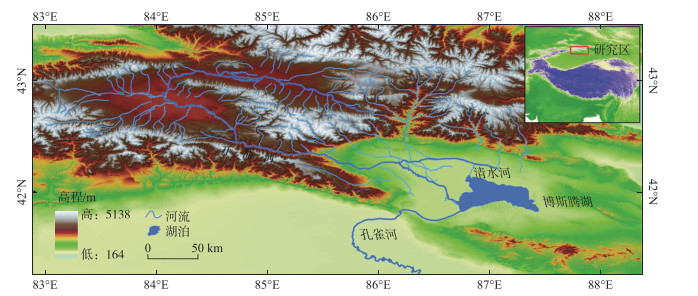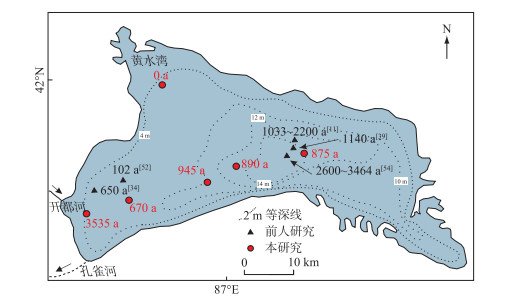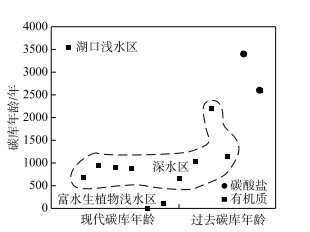(2: 兰州大学地质科学与矿产资源学院,兰州 730000)
(3: 佛山科学技术学院环境与化学工程学院,佛山 528000)
(2: School of Geological Sciences and Mineral Resources, Lanzhou University, Lanzhou 730000, P.R.China)
(3: School of Environmental and Chemical Engineering, Foshan University, Foshan 528000, P.R.China)
气候在很大程度上制约了人类社会的发展,古环境重建对未来气候的预测有重要意义。西部地区广泛分布的湖泊沉积物完整地记录了古气候信息。湖泊沉积物剖面年龄控制依赖于14C测年,然而大多数湖泊存在碳库效应,严重制约了利用湖泊沉积物对古气候的研究。湖泊碳库效应,是指湖泊水体碳库中缺乏14C而造成的年龄失真,且其随时间与空间而变化[1]。早在1960s前,碳库效应问题就已被学者发现[2]。尤其在1980s的海洋研究中,学者们发现海水及沉积物的放射性碳特征差异问题,并通过实验探究了这种碳库效应的过程[3-4]。已有研究表明其变化范围在数百年至数千年之间[5-8]。例如:仅在淡水河流或者湖泊中,碳库效应高达2000年[7-8]。
前人对沉积过程中碳库效应开展研究,通过利用不同测年方法[9-10]与不同测年材料对比方法[11-12],得出了过去湖泊碳库年龄变化范围,探讨了影响碳库的主要因素。例如,班公错[13-14]、青海湖[15-18]等具有多个碳库年龄。而且,青海湖1F孔发现不同时期也具有多个碳库年龄[19]。无疑,湖泊过去的碳循环很难被确定;沉积过程中,不同湖区碳库效应影响因素很可能不一致,这增加了评估碳库效应的不确定性。
测量湖泊现代组分(如:表层全有机质、现生动植物、自生碳酸盐等)14C年代作为现代碳库年龄,有效地避开了湖泊演化过程带来的问题,在碳库研究中得到广泛的应用[20-27],尤其在碳库效应的影响因素的研究中逐渐成为热点[5-6, 9, 11, 17, 27-30]。例如前人在内蒙古岱海[27]、英错[30]、懂错[30]、错鄂湖[22, 17]、兹格塘错[22, 31]、青海湖[17-18, 31-33]、黑海[24]、云南阳宗海[34]、班公错[13]、冬给错纳湖[9]、库塞湖[10]、更尕海[28]、当惹雍错[35]等开展研究,表明湖泊的碳库效应在空间上存在明显的差异性;湖水区地质背景(碳酸盐岩最为明显)、湖水滞留时间、泥炭与湖泊沼泽等是影响碳库年龄的主要因素[5];另外,地壳上升古老“CO2”、核爆效应也是影响碳库分布的主要因素[9, 36]。但前人研究大多数以咸水湖泊为主,复杂碳源贡献导致难以清楚地解释碳库效应影响。
地处典型的西风环流带的内陆淡水博斯腾湖流域经历了复杂快速的环境变化[37]。湖泊中的沉积物则是记录这种气候快速变化过程、开展未来预测研究的理想载体[37-43]。前人已在博斯腾湖开展了大量碳库效应研究[11, 42, 44-45],例如,有学者认为博斯腾湖晚全新世以来碳库效应主要受水体与大气CO2中14C交换差异影响[11]。然而,这些研究更多侧重过去碳库效应的研究,受沉积过程影响较大,而要解决碳库效应影响机制问题,需准确掌握现代碳库效应的变化规律和控制因素。因此,本文将选择博斯腾表层湖泊沉积物中全有机质作为现代测年材料进行14C测年(作为现代碳库年龄),结合湖泊水体物理-化学性质、沉积物同位素地球化学等信息,拟解决以下问题:(1)博斯腾湖碳库空间变化规律如何?(2)影响博斯腾湖碳库变化的主要因素是什么?
1 研究区概况博斯腾湖,又名巴喀刺赤海,是中国最大的内陆淡水湖泊。该湖位于新疆天山南,焉耆盆地东南,属于中生代断陷湖,除开都河为主要入水河流外,还包括清水河、孔雀河等河流(图 1)。其中开都河流量最大,平均年径流量34.20×108 m3,约占入湖量83.4 %,是常年性河流,且发源于西天山中部,由冰雪融水和山地降水补给为主。孔雀河从西南角出湖[46]。博斯腾湖泊面积1160 km2,蓄水量为84.1×108 m3,水深为8~15 m,平均水深为8.1 m,HCO3-为146.4~206.5 g/L,CO32-为20.2~45.0 g/L,总碱度为158.5~206.8 mg/L[46-47]。湖区基岩以花岗岩类、闪长岩、超基性岩为主[48]。盆地四周为前第四纪地层,其内部广泛分布第四纪冲洪积、沼泽和湖积物。盆地第四纪岩性结构自西北向东南逐渐变细,以砂砾石、中粗砂、中细砂、砂壤土、亚黏土为主。滨湖由海拔2000~3000 m的山地环绕。博斯腾湖地区受塔克拉玛干沙漠干热气候的强烈影响,表现为沙漠荒漠气候,干燥少雨。根据焉耆与库尔勒地区近50年来的气象资料显示,焉耆年均气温8.4℃,年降雨量74.4 mm。博斯腾湖由大小不同的两个湖区组成,位于大湖的西南端分布有许多小湖,芦苇茂盛[46]。

|
图 1 新疆博斯腾湖地理位置 Fig.1 Geographical location of Lake Bosten in Xinjiang |
博斯腾湖现主要有水生植物12属12种,以聚草、眼子菜、大茨藻和芦苇为主,主要分布在西北、西南、东南湖湾。水生植物从湖岸到中心分布有芦苇(Phragmites australis)群落、香蒲(Typha orientalis)群落、浮水植物睡莲(Nymphaea tetragona)群落、荇菜(Nymphoides peltatum)、眼子菜(Potamogeton distinctus)等,水深>120 cm处以沉水植物(次藻)为主,水深>200 cm处无水生植物。
2 样品采集与实验分析 2.1 样品采集博斯腾湖沉积物采样时间分为2004年12月与2015年12月两次进行,选取表层深度0~1 cm,共采集样品6个。在各采样点使用便携式水质仪测试电导率、盐度、水深、水温与pH等指标(水体温度、盐度在各采样点均无明显差异)。样品采集完成后装入样品袋密封保存,并运回实验室冷冻干燥。
2.2 样品分析 2.2.1 对沉积物进行AMS14C测年选取博斯腾湖不同位置表层沉积物样品6个(包括:入湖口浅水区BH-2、深水区BH-9、深水区BH-12、深水区BH-14、深水区BH-16与富水生植物浅水区BH-37)用于14C测年。首先把样品进行酸-碱-酸处理后,采用H2-Fe法进行石墨化。反应完成后将铁粉和石墨混合物用锡箔纸包好,在SDH1.5串列静电加速器进行测试。前处理与制靶均在兰州大学西部与环境教育部重点实验室内自动化石墨化设备(AGE 3)、加速器石墨靶合成系统(自主研发)完成,AMS 14C年代测试在北京大学年代实验室完成,采用MICADAS加速器质谱仪测量精度固体可达14C/12C 0.2 %,气体可达14C/12C 0.8 %。14C本底可达50000 aBP。
2.2.2 湖泊沉积物碳酸盐含量(CaCO3含量)及无机δ13Ccarb、δ18Ocarb测定湖泊沉积物冷冻干燥后,分离出草根等植物残体。称取适量的湖泊沉积物、碳酸盐,与10% 的HCl发生反应,再测定CO2气体的压力,然后再计算后得到沉积物中CaCO3含量,实验测试误差为 < 1 %。沉积物样品过200目筛。已有的研究表明,沉积物中粒径(200~300目)的颗粒碳酸盐主要以自生碳酸盐为主[49]。将筛选后沉积物样品加入同位素分析前处理系统中,在真空条件下,与100% 浓磷酸反应产生CO2,纯化后收集到指状样品管中,后加入到MAT-252同位素仪中进行测试。并用NBA-19和实验室标样进行误差控制,分析误差 < 0.3 ‰。分析结果以V-PDB表示[50],在中国科学院兰州气体地化实验室完成测试。
2.2.3 沉积物风化指数测定湖泊沉积物样品利用HNO3-HF-HClO4进行处理。元素包括Al、Fe、K、Na、Ca、Mg、P、Ti、Ba含量,采用电感耦合等离子体发射光谱法(ICP-OES)测定,仪器型号为Agilent720Axial,分析精度均小于1.0 %。风化指数依据CIA(chemical index of alteration)、CIW(chemical index of weathering)与PLA(plagioclase alteration)计算公式得出[51]。在兰州大学资源与环境教育部重点实验室进行测定。
3 结果如表 1、2,博斯腾湖表层沉积物BH-2、BH-9、BH-12、BH-14、BH-16与BH-37,采样湖水深度分别为4.3、10.1、10.7、13、14.2和5.8 m,对应14C年代测试结果依次为3535、670、945、890、875年和现代碳,pMC% (放射性碳比活度)依次为64.39 %、91.98 %、88.92 %、89.52 %、89.66% 和100.47 %。样品BH-2的δ13Ccarb值为-1.5 ‰,BH-37为1.7 ‰,BH-9、BH-12、BH-14、BH-16依次为0.8 ‰、1.4 ‰、0.7 ‰、0.8 ‰。博斯腾湖表层沉积物中CaCO3含量开都河入湖口BH-2为20.8 %,富水生植物浅水区BH-37为50.5 %,其余深水区BH-9、BH-12、BH-14与BH-16的CaCO3含量为35.3% ~40.5 %。博斯腾开都河入湖口BH-2采样位置湖水pH为6.8,浅水区BH-37为8.0,其余深水区BH-9、BH-12、BH-14与BH-16的pH依次为7.2、7.4、7.4与7.6。博斯腾开都河入湖口浅水区BH-2风化指数CIA、CIW、PLA分别为35.2、40.2、30.3,BH-37分别为6.4、6.5、4.5,BH-9、BH-12、BH-14与BH-16分别为(14.8~16.5)、(15.5~17.4)与(11.1~12.5)。同一个湖泊湖水中电导率相差不明显。
| 表 1 博斯腾湖样品采集地点及描述 Tab. 1 Sample collection site and description in Lake Bosten |
| 表 2 博斯腾湖表层沉积物14C年代测试结果 Tab. 2 The 14C age results of surface sediments in Lake Bosten |
如图 2所示,博斯腾湖碳库年龄最高达3535年,大多集中于670~945年,而最小为现代碳。从采样深度来看,样品BH-2和BH-37采样靠近湖岸边,深度较浅;其中,BH-37处水生植物丰富。BH-9(10.1 m)、BH-12(10.3 m)、BH-14(13.0 m)与BH-16(14.2 m),离湖岸较远位置,水深较深。前人通过其它的碳库校正方法,得出了5个博斯腾湖碳库效应;其中,Wünnemann等 [52]选取博斯腾湖西南岩芯样品,认为碳库效应很小且可忽略(~102年)。张成君等 [45]得出博斯腾湖沉积物有机质14C测年偏老约650年左右。黄小忠[53]采用14C测年、137Cs与210Pb测年方法,认为博斯腾湖碳库年龄为1140年。Zhang等 [54]利用博斯腾湖岩芯中自生碳酸盐所得出全新世以来平均碳库年龄为3400年,最大为3464年,最小为2600年。结合前人的研究结果,Zhou等 [11]探讨晚全新世以来博斯腾湖碳库年龄为1033~2200年。

|
图 2 新疆博斯腾湖碳库年龄分布 Fig.2 Distribution plot of the 14C pool age in Lake Bosten |
前人所得碳库年龄分别为~650年[45]、1140年[53]、~102年[52]、1033年[11]、2200年[11]、3400年[54];与本次所得年龄相比较,结果显示博斯腾湖3535年为最大的碳库年龄,位置在开都河河口区,与利用自生碳酸盐所得最大碳库效应3464年[54]较接近。其次,浅水区(水生植物丰富)BH-37表现为现代碳,为博斯腾湖最小碳库,与~102年[52]碳库效应接近。在湖泊深水区为670~945年,与前人所得~650年[45]、1033年[11]、1140年[53]碳库年龄相比,结果接近,但本次现代碳库年龄表现更为年轻(图 3)。此外,前人自生碳酸盐所得碳库效应最小为2600年[54],最大为3464年[54],其结果明显高于全有机质碳库效应(除河口处3535年碳库效应外)。

|
图 3 博斯腾湖碳库年龄对比 Fig.3 Comparison of 14C pool ages in Lake Bosten |
通过对碳库年龄与环境因子相关性分析(表 3),并依据相关系数0.5~1.0为强相关性,0.3~0.5为中相关性,0.1~0.3为弱相关性。博斯腾湖现代碳库年龄与风化强度呈强正相关性,与pH、CaCO3含量、δ13Ccarb呈强负相关性;与水深、电导率呈负中等相关性。综上,强风化作用可指示流域内碎屑参与,距离湖岸越近受外源碎屑影响越大。尽管博斯腾湖区基岩以花岗岩类、闪长岩、超基性岩为主[48],但湖盆内多以碳酸盐胶结为主的砂岩为主,这类岩屑的存在同样会影响碳库年龄分布[55]。而水深变化与碳库年龄也揭示了离湖岸越近,受流域内碳酸质岩屑影响更大[54],碳库效应越大;反之,碳库效应越小。
| 表 3 碳库年龄与环境因子相关系数矩阵 Tab. 3 Correlation coefficient matrix between 14C pool ages and environmental factors |
博斯腾湖最大碳库年龄分布在浅水开都河口。并与前人所得最大碳酸盐碳库年龄接近。前人[55]研究发现开都河入湖口δ13Ccarb、CaCO3含量与其它湖区域存在明显的差异(图 4),是由于流域内携带外源碳酸质碎屑的影响。由于浅水区,且河口处水动力大,流域内外源碎屑碳酸质岩屑对δ13Ccarb造成影响,致使δ13Ccarb值偏负[56]。前期矿物分析认为在开都河口为石英+长石+方解石矿物组合,其中石英所占比例最大,方解石以外源为主[50]。本次开都河口δ13Ccarb同位素(-1.5 ‰)明显偏负值,且CaCO3含量最小,揭示河口外源碳酸质碎屑的影响较大。另外,开都河口最大的风化强度(CIA、CIW、PIA),也说明从流域内(开都河)带入的外源碎屑较多。而水生植物在利用湖水中水溶无机碳DIC进行光合作用时,外源碳酸质岩屑中“死”碳进入水生植物体内,有机质沉积带来碳库效应。加之,有研究认为入湖口有机碳来源主要为内源水生植物贡献[56]。无疑,流域内外源碳酸质岩屑中“死”碳会导致开都河口碳库效应高于其它区域。类似的研究结果也同样出现在岱海[27]、库塞湖[30]、黑海[24]、冬给错纳湖[9]、更尕海[28]等湖泊。除此之外,博斯腾湖也受西河口附近湿地中“老”有机碳[54, 57]影响。

|
图 4 博斯腾湖沉积物δ13Ccarb与δ18Ocarb、δ13Ccarb与CaCO3含量相关性[50] Fig.4 Correlation of δ13Ccarb and δ18Ocarb, δ13Ccarb and CaCO3 content in Lake Bosten sediments[50] |
本次博斯腾湖最小现代碳库年龄出现在黄水湾,该处水生植物丰富。并与前人~102年[52]最小现代碳库效应较为接近。该区域δ13Ccarb(1.7 ‰)为正值且最大,风化强度最小,CaCO3含量却最大(图 4)。风化强度小说明了来自外源碎屑影响最小。δ13Ccarb为正值且最大,指示了较强的湖水与大气CO2交换率。而在外源碎屑影响最小的区域,CaCO3含量最大指示了自生碳酸盐矿物为主,而水生植物光合速率直接会影响自生碳酸盐矿物的结晶[58]。黄水湾丰富的藻类以及沉水植物生长,提高了水生植物光合作用,进而“消耗”湖水中更多的“老”CO2[38, 58],增加了湖水与大气中“新”CO2的交换速率[28, 58-59],使湖水中CO2得到了更快地更新。因此,湖岸浅水区水生植物光合作用可能提高湖水与大气中CO2的交换速率,使水中CO2得到更新,进而导致碳库效应变小。Li等 [28]在青海更尕海也发现了水生植物光合作用直接影响碳库效应变化。
博斯腾碳库年龄范围变化不大的区域出现在离湖岸较远的深水区,与前人所得~650年[45]、1033年[11]、1140年[53]过去碳库效应相差不大。深水区δ13Ccarb值偏正,CaCO3含量与风化强度指数接近且变化小,指示了深水区湖泊水体滞留时间长,水体动力环境较稳定,受外源碳酸盐影响较小,湖水与大气中CO2的交换差异可能是主要影响因素。前期[50]矿物分析也认为深水区矿物组合为文石+方解石+石英+长石,以文石与方解石为主,其中以自生碳酸盐矿物为主,进而说明湖水与大气中CO2是主要影响因素。加之博斯腾湖较长的冰期(11月-次年4月)可能会加剧湖泊水体-大气CO2交换不充分,导致湖泊内DIC的逐渐老化[54]。前人在博斯腾湖过去碳库效应研究中也证实了水体与大气CO2中14C交换差异影响其变化[11]。
4.2.3 核爆效应的影响由于全球核爆效应影响,大气中14C浓度在1950年前明显低于1950年后[60-61]。一般情况下,14C年代是以放射性碳比活度为1(=100 pMC,percent Modern Carbon)进行计算。但湖泊沉积物在沉积初期大气14C浓度较现在高。而表层全有机质14C测年需利用现在大气放射性碳比活度进行年龄计算,将导致低估了样品的实际沉积年龄[9]。因而,博斯腾湖过去碳库年龄老于现代碳库年龄。前人利用210Pb、228Th方法,计算出博斯腾湖沉积物沉积速率为0.31、0.26和0.33 cm/a[62],得出0~1 cm的表层沉积物需3~4年。张成君等 [45]运用137Cs与14C年代对比分析,认为平均沉积物速率为(0.13±0.03) cm/a,可计算出0~1 cm的表层沉积物需0~7.7年。而钟巍和舒强 [63]在博斯腾湖泥炭层剖面中认为平均沉积速率为0.026 cm/a,得出0~1 cm表层沉积物需0~38.5年。在较短的沉积时间内,14C碳比活度无明显变化。但在较长的沉积时间内,14C碳比活度变化显著。例如,在16~40年之间,14C碳比活度会下降5% ~20 %,利用14C年代计算公式 [64],根据现代大气放射性碳比活度107% ~109% [65],计算出全球核爆效应可能会导致最高约1000年的年代误差。综上,对于表层沉积物现代碳库年龄而言,核爆效应对沉积速率较慢的湖区影响较大,表层沉积物碳库年龄只代表了碳库效应的最小值[9]。因此,建议在采集表层沉积物时,尽可能使样品采集深度更小,从而降低碳比活度变化差异带来的年龄误差。
与现代大气放射性碳比活度107% ~109% [65]相比较,博斯腾湖表层沉积物的14C pMC值存在明显差异。根据湖水14C收支平衡取决于大气14C水平和水文条件[18, 66],开都河入湖量约占83.4 %,浅水河口受流域外源碳酸质碎屑“死碳”影响最大,而深水区外源碳酸质碎屑影响小,主要受水体与大气中CO2中14C交换差异影响。因此,在选择采样点时,要避开湖边、河口等位置。博斯腾湖深水区表层沉积物中明显亏损14C,与现代大气碳比活度相比亏损达~18% pMC(取深水区pMC平均值~90% 与大气碳比活度107% ~109% [65]平均值的差值),利用14C年代计算公式[64],依据放射性碳比活度为1.08进行计算,得出14C年龄约846年。因此,认为博斯腾湖表层沉积物的全有机质存在约846年现代碳库效应。然而,依据前人所得沉积物速率大气14C碳比活度在16~40年里下降了5% ~20 %,则最高会导致约1000年的年代误差。因此,经校正后博斯腾湖存在最高约1800年碳库效应,其与前人过去碳库年龄1033~2200年相对应。
5 结论1) 博斯腾湖最大现代碳库年龄为3535年,最小为现代碳,集中为670~945年。过去碳库效应为650~2200年,集中于1033~2200年。在湖口浅水区碳库效应最大;富集水生植物浅水区最小;深水区表现为碳库年龄较小且稳定;过去碳库年龄老于现代碳库。
2) 博斯腾湖开都河口主要来自流域外源“死”碳影响较大,但河口附近湿地中“老”有机碳影响并不能排除;深水区湖水由于滞留时间久,主要受湖水与大气CO2交换差异影响。富水生植物浅水区是由于植物光合作用提高了湖水与大气中CO2的交换率,使湖水中CO2得到了较快更新,进而导致碳库效应变小。由于全球核爆效应影响,对于沉积速率较慢的湖区,现代碳库年龄只代表了碳库效应的最小值。
3) 博斯腾湖表层沉积物全有机质存在约846年现代碳库效应,经核爆效应校正后博斯腾湖可能会存在最高约1800年碳库效应。
在选择采样点时,要避开湖边、河口等位置。同时,在采取表层沉积物样品时,尽可能控制较小采样深度,从而降低碳比活度变化差异带来的年龄误差。
| [1] |
Watanabe T, Matsunaka T, Nakamura T et al. Last glacial-Holocene geochronology of sediment cores from a high-altitude Tibetan Lake based on AMS 14C dating of plant fossils: Implications for paleoenvironmental reconstructions. Chemical Geology, 2010, 277(1/2): 21-29. DOI:10.1016/j.chemgeo.2010.07.004 |
| [2] |
Deevey ES, Gross MS, Hutchinson GE et al. The natural C contents of materials from hard-water lakes. Proceedings of the National Academy of Sciences of the United States of America, 1954, 40(5): 285-288. DOI:10.1073/pnas.40.5.285 |
| [3] |
Sutherland DG. Problems of radiocarbon dating deposits from newly deglaciated terrain: Examples from the Scottish Lateglacial. Oxford: Pergamon Press, 1980, 139-149. |
| [4] |
Olsson. Radiometric dating. In: Berglund BE ed. Handbook of Hollocene Palaeoecology and Palaohydrology. New York: Willy, 1986: 273-312.
|
| [5] |
Hou JZ, D'Andrea WJ, Liu ZH. The influence of 14C reservoir age on interpretation of paleolimnological records from the Tibetan Plateau. Quaternary Science Reviews, 2012, 48: 67-79. DOI:10.1016/j.quascirev.2012.06.008 |
| [6] |
Zhou WJ, Chui YD, Yang L et al. 14C geochronology and radiocarbon reservoir effect of reviewed lakes study in China. Radiocarbon, 2022, 64(4): 833-844. DOI:10.1017/rdc.2021.92 |
| [7] |
Keaveney EM, Reimer PJ. Understanding the variability in freshwater radiocarbon reservoir offsets: A cautionary tale. Journal of Archaeological Science, 2012, 39(5): 1306-1316. DOI:10.1016/j.jas.2011.12.025 |
| [8] |
Ascough PL, Church MJ, Cook GT et al. Radiocarbon reservoir effects in human bone collagen from northern Iceland. Journal of Archaeological Science, 2012, 39(7): 2261-2271. DOI:10.1016/j.jas.2012.02.012 |
| [9] |
Mischke S, Weynell M, Zhang CJ et al. Spatial variability of 14C reservoir effects in Tibetan Plateau Lakes. Quaternary International, 2013, 313/314: 147-155. DOI:10.1016/j.quaint.2013.01.030 |
| [10] |
Zhang Q, Liu XQ, Li HS. Impact of hydrological conditions on the radiocarbon reservoir effect in lake sediment 14C dating: The case of Kusai Lake on the northern Qinghai-Tibet Plateau. Quaternary Geochronology, 2021, 62: 101149. DOI:10.1016/j.quageo.2020.101149 |
| [11] |
Zhou KE, Xu H, Lan JH et al. Variable late Holocene 14C reservoir ages in Lake Bosten, northwestern China. Frontiers in Earth Science, 2020, 7: 328. DOI:10.3389/feart.2019.00328 |
| [12] |
Zhou AF, He YX, Wu D et al. Changes in the radiocarbon reservoir age in Lake Xingyun, Southwestern China during the Holocene. PLoS One, 2015, 10(3): e0121532. DOI:10.1371/journal.pone.0121532 |
| [13] |
Fontes JC, Gasse F, Gibert E. Holocene environmental changes in Lake Bangong Basin (Western Tibet). Part 1: Chronology and stable isotopes of carbonates of a Holocene lacustrine core. Palaeogeography, Palaeoclimatology, Palaeoecology, 1996, 120(1/2): 25-47. DOI:10.1016/0031-0182(95)00032-1 |
| [14] |
Gasse F, Fontes JC, Van Campo E et al. Holocene environmental changes in Bangong Co basin (Western Tibet). Part 4: Discussion and conclusions. Palaeogeography, Palaeoclimatology, Palaeoecology, 1996, 120(1/2): 79-92. DOI:10.1016/0031-0182(95)00035-6 |
| [15] |
Shen J, Liu XQ, Wang SM et al. Palaeoclimatic changes in the Qinghai Lake area during the last 18, 000 years. Quaternary International, 2005, 136(1): 131-140. DOI:10.1016/j.quaint.2004.11.014 |
| [16] |
Zhang PX, Zhang BZ, Qian GM et al. The study of paleoclimatic parameter of Qinghai Lake since Holocene. Quaternary Sciences, 1994, 14(3): 225-238. [张彭熹, 张保珍, 钱桂敏等. 青海湖全新世以来古环境参数的研究. 第四纪研究, 1994, 14(3): 225-238. DOI:10.3321/j.issn:1001-7410.1994.03.004] |
| [17] |
Henderson ACG, Holmes JA, Leng MJ. Late Holocene isotope hydrology of Lake Qinghai, NE Tibetan Plateau: Effective moisture variability and atmospheric circulation changes. Quaternary Science Reviews, 2010, 29(17/18): 2215-2223. DOI:10.1016/j.quascirev.2010.05.019 |
| [18] |
Yu SY, Shen J, Colman SM. Modeling the radiocarbon reservoir effect in lacustrine systems. Radiocarbon, 2007, 49(3): 1241-1254. DOI:10.1017/s0033822200043150 |
| [19] |
Zhou WJ, Cheng P, Timothy Jull AJ et al. 14C chronostratigraphy for Qinghai Lake in China. Radiocarbon, 2014, 56(1): 143-155. DOI:10.2458/56.16470 |
| [20] |
Qiang MR, Chen FH, Zhang JW et al. Climate change recorded by stable isotopes of sedimentary carbonates in lake sugan in 2ka. Chinese Science Bulletin, 2005, 50(13): 1385-1393. [强明瑞, 陈发虎, 张家武等. 2ka来苏干湖沉积碳酸盐稳定同位素记录的气候变化. 科学通报, 2005, 50(13): 1385-1393. DOI:10.3321/j.issn:0023-074X.2005.13.016] |
| [21] |
Wu YH, Wang SM, Hou XH. Chronology of Holocene Lake sediments in Cuo'e, central Qinghai-Tibet Plateau. Science in China: Series D: Earth Sciences, 2006, 36(8): 713-722. [吴艳宏, 王苏民, 侯新花. 青藏高原中部错鄂全新世湖泊沉积物年代学研究. 中国科学: D辑: 地球科学, 2006, 36(8): 713-722.] |
| [22] |
Wu YH, Li SJ, Lücke A et al. Lacustrine radiocarbon reservoir ages in Co Ngoin and Zigê Tangco, central Tibetan Plateau. Quaternary International, 2010, 212(1): 21-25. DOI:10.1016/j.quaint.2008.12.009 |
| [23] |
Hatté C, Jull AJT. Radiocarbon dating | 14C of plant macrofossils. Encyclopedia of quaternary science. Amsterdam: Elsevier, 2013: 361-367. DOI: 10.1016/b978-0-444-53643-3.00049-2.
|
| [24] |
Lockot G, Ramisch A, Wünnemann B et al. A process- and provenance-based attempt to unravel inconsistent radiocarbon chronologies in lake sediments: An example from Lake Heihai, North Tibetan Plateau (China). Radiocarbon, 2015, 57(5): 1003-1019. DOI:10.2458/azu_rc.57.18221 |
| [25] |
Blattmann TM, Wessels M, McIntyre CP et al. Projections for future radiocarbon content in dissolved inorganic carbon in hardwater lakes: A retrospective approach. Radiocarbon, 2018, 60(3): 791-800. DOI:10.1017/rdc.2018.12 |
| [26] |
Soulet G, Giosan L, Flaux C et al. Using stable carbon isotopes to quantify radiocarbon reservoir age offsets in the coastal black sea. Radiocarbon, 2019, 61(1): 309-318. DOI:10.1017/rdc.2018.61 |
| [27] |
Wu YH, Wang SM, Zhou LP et al. Modern reservoir age for 14C dating in Daihai Lake. Quaternary Sciences, 2007, 27(4): 507-510. [吴艳宏, 王苏民, 周力平等. 岱海14C测年的现代碳库效应研究. 第四纪研究, 2007, 27(4): 507-510. DOI:10.3321/j.issn:1001-7410.2007.04.005] |
| [28] |
Li Y, Qiang MR, Jin YX et al. Influence of aquatic plant photosynthesis on the reservoir effect of Genggahai Lake, northeastern Qinghai-Tibetan Plateau. Radiocarbon, 2018, 60(2): 561-569. DOI:10.1017/rdc.2017.127 |
| [29] |
Apolinarska K, Pełechaty M, Pukacz A. CaCO3 sedimentation by modern charophytes (Characeae): Can calcified remains and carbonate δ13C and δ18O record the ecological state of lakes?—A review. Studia Limnologica et Telmatologica, 2011, 5(2): 55-66. |
| [30] |
Du DD, Li ZW, Hu HP et al. Influences of environmental factors on the modern 14C reservoir effects in Qinghai-Tibet Plateau Lakes. Journal of Mountain Science, 2021, 18(12): 3179-3189. DOI:10.1007/s11629-020-6495-3 |
| [31] |
Wang Y, Shen J, Wu J et al. Hard-water effect correction of lacustrine sediment ages using the relationship between 14C levels in lake waters and in the atomosphere: The case of Lake Qinghai. J Lake Sci, 2007, 19(5): 504-508. [汪勇, 沈吉, 吴健等. 湖泊沉积物14C年龄硬水效应校正初探——以青海湖为例. 湖泊科学, 2007, 19(5): 504-508. DOI:10.18307/2007.0502] |
| [32] |
Liu XQ, Shen J, Wang SM et al. Southwest monsoon changes indicated by oxygen isotope of ostracode shells from sediments in Qinghai Lake since the late Glacial. Chinese Science Bulletin, 2007, 52(4): 539-544. DOI:10.1007/s11434-007-0086-3 |
| [33] |
Cheng P, Lu XF, Du H et al. The preliminary study of spatio-temporal change of old carbon effect in Lake Qinghai(NE Tibet-Qinghai Plateau), China. Journal of Earth Environment, 2016, 7(4): 357-365. [程鹏, 卢雪峰, 杜花等. 青海湖老碳效应的时空变化初步研究. 地球环境学报, 2016, 7(4): 357-365. DOI:10.7515/JEE201604004] |
| [34] |
Yu MM, Meng HW, Chen JL et al. The radiocarbon reservoir effects of lake in Yunnan. Quaternary Sciences, 2023, 43(2): 390-402. [于苗苗, 蒙红卫, 陈金龙等. 云南湖泊碳库效应. 第四纪研究, 2023, 43(2): 390-402.] |
| [35] |
Haberzettl T, Henkel K, Kasper T et al. Independently dated paleomagnetic secular variation records from the Tibetan Plateau. Earth and Planetary Science Letters, 2015, 416: 98-108. DOI:10.1016/j.epsl.2015.02.007 |
| [36] |
仇士华. 中国14C年代学研究. 北京: 科学出版社, 1990.
|
| [37] |
Chen FH, Huang XZ, Yang ML et al. Westerly dominated Holocene climate model in arid central asia—Case study on Bosten Lake, Xinjiang, China. Quaternary Sciences, 2006, 26(6): 881-887. [陈发虎, 黄小忠, 杨美临等. 亚洲中部干旱区全新世气候变化的西风模式——以新疆博斯腾湖记录为例. 第四纪研究, 2006, 26(6): 881-887. DOI:10.3321/j.issn:1001-7410.2006.06.001] |
| [38] |
Zhang CJ, Zheng MP, Prokopenko A et al. The palaeoenvironmental variation from the high-resolution record of the Holocene sediment carbonate and isotopic composition in Bosten Lake and responding to glacial activit. Acta Geologic Sinica, 2007, 81(12): 1658-1671. [张成君, 郑绵平, Prokopenko A等. 博斯腾湖碳酸盐和同位素组成的全新世古环境演变高分辨记录及与冰川活动的响应. 地质学报, 2007, 81(12): 1658-1671. DOI:10.3321/j.issn:0001-5717.2007.12.007] |
| [39] |
Huang XZ, Chen FH, Fan YX et al. Dry late-glacial and early Holocene climate in arid central Asia indicated by lithological and palynological evidence from Bosten Lake, China. Quaternary International, 2009, 194(1/2): 19-27. DOI:10.1016/j.quaint.2007.10.002 |
| [40] |
Zhang JW, Wang JL, Guo XY et al. Paleoclimatic significance of oxygen isotope composition of carbonates from a sediment core at Bosten Lake, Xinjiang, China. Quaternary Sciences, 2010, 30(6): 1078-1087. [张家武, 王君兰, 郭小燕等. 博斯腾湖全新世岩芯沉积物碳酸盐氧同位素气候意义. 第四纪研究, 2010, 30(6): 1078-1087. DOI:10.3969/j.issn.1001-7410.2010.06.02] |
| [41] |
Zhang Y, Meyers PA, Liu XT et al. Holocene climate changes in the central Asia Mountain region inferred from a peat sequence from the Altai Mountains, Xinjiang, northwestern China. Quaternary Science Reviews, 2016, 152: 19-30. DOI:10.1016/j.quascirev.2016.09.016 |
| [42] |
Li GQ, Duan YW, Huang XZ et al. The luminescence dating chronology of a deep core from Bosten Lake (NW China) in arid central Asia reveals lake evolution over the last 220ka. Boreas, 2017, 46(2): 264-281. DOI:10.1111/bor.12209 |
| [43] |
Huang XZ, Xiang LX, Lei GL et al. Sedimentary Pediastrum record of middle-late Holocene temperature change and its impacts on early human culture in the desert-oasis area of northwestern China. Quaternary Science Reviews, 2021, 265: 107054. DOI:10.1016/j.quascirev.2021.107054 |
| [44] |
杜丁丁. 中国西部地区湖泊碳库效应的影响因素及评价[学位论文]. 兰州: 兰州大学, 2018.
|
| [45] |
Zhang CJ, Cao J, Lei YB et al. The chronological characteristics of Bosten Lake Holocene sediment environment in Xinjiang, China. Acta Sedimentologica Sinica, 2004, 22(3): 494-499. [张成君, 曹洁, 类延斌等. 中国新疆博斯腾湖全新世沉积环境年代学特征. 沉积学报, 2004, 22(3): 494-499. DOI:10.3969/j.issn.1000-0550.2004.03.017] |
| [46] |
Wu JL, Ma L, Zeng HA. Water quality and quantity characteristics and its evolution in Lake Bosten, Xinjiang over the past 50 years. Scientia Geographica Sinica, 2013, 33(2): 231-237. |
| [47] |
Xie GJ, Zhang JP, Tang XM et al. Spatio-temporal heterogeneity of water quality(2010-2011) and succession patterns in Lake Bosten during the past 50 years. J Lake Sci, 2011, 23(6): 837-846. [谢贵娟, 张建平, 汤祥明等. 博斯腾湖水质现状(2010-2011年)及近50年来演变趋势. 湖泊科学, 2011, 23(6): 837-846. DOI:10.18307/2011.0603] |
| [48] |
褚兆晶. 新疆博斯腾湖表层沉积物金属元素地球化学特征研究[学位论文]. 兰州: 兰州大学, 2012.
|
| [49] |
Jiang JM, Wu JL. Lake sediment records of the Holocene environmental evolution in North Xinjiang. Geological Journal of China Universities, 2003, 9(1): 30-37. [姜加明, 吴敬禄. 北疆地区早全新世环境演化的湖泊沉积记录. 高校地质学报, 2003, 9(1): 30-37. DOI:10.3969/j.issn.1006-7493.2003.01.004] |
| [50] |
Zhang CJ, Mischke S, Zheng MP et al. Carbon and oxygen isotopic composition of surface-sediment carbonate in Bosten Lake (Xinjiang, China) and its controlling factors. Acta Geologica Sinica-English Edition, 2009, 83(2): 386-395. DOI:10.1111/j.1755-6724.2009.00029.x |
| [51] |
Du DD, Chen LQ, Bai YH et al. Variations in rare earth elements with environmental factors in lake surface sediments from 17 lakes in Western China. Journal of Mountain Science, 2021, 18(7): 1811-1822. DOI:10.1007/s11629-020-6040-4 |
| [52] |
Wünnemann B, Mischke S, Chen FH. A Holocene sedimentary record from Bosten Lake, China. Palaeogeography Palaeoclimatology Palaeoecology, 2006, 234. DOI:10.1016/j.palaeo.2005.10.016 |
| [53] |
黄小忠. 新疆博斯腾湖记录的亚洲中部干旱区全新世气候变化研究[学位论文]. 兰州: 兰州大学, 2006.
|
| [54] |
Zhang JW, Ma XY, Qiang MR et al. Developing inorganic carbon-based radiocarbon chronologies for Holocene Lake sediments in arid NW China. Quaternary Science Reviews, 2016, 144: 66-82. DOI:10.1016/j.quascirev.2016.05.034 |
| [55] |
Liu ZH, Dreybrodt W, Liu H. Atmospheric CO2 sink: Silicate weathering or carbonate weathering?. Applied Geochemistry, 2011, 26: S292-S294. DOI:10.1016/j.apgeochem.2011.03.085 |
| [56] |
Yu ZT, Wang XJ, Zhao CY et al. Source characterization of organic carbon using elemental, isotopic and n-alkanes proxies in surface sediment from Lake Bosten, Xinjiang. J Lake Sci, 2015, 27(5): 983-990. [于志同, 王秀君, 赵成义等. 基于多指标分析的博斯腾湖表层沉积物有机碳来源. 湖泊科学, 2015, 27(5): 983-990. DOI:10.18307/2015.0526] |
| [57] |
Zhong W, Xiong HG. Isotopic evidence for Holocene climatic changes in Bosten Lake, Southern Xinjiang, China. Chinese Geographical Science, 1998, 8(2): 176-182. DOI:10.1007/s11769-997-0032-y |
| [58] |
Obst M, Wehrli B, Dittrich M. CaCO3 nucleation by cyanobacteria: Laboratory evidence for a passive, surface-induced mechanism. Geobiology, 2009, 7(3): 324-347. DOI:10.1111/j.1472-4669.2009.00200.x |
| [59] |
Longhurst AR, Glen HW. The biological pump: Profiles of plankton production and consumption in the upper ocean. Progress in Oceanography, 1989, 22(1): 47-123. DOI:10.1016/0079-6611(89)90010-4 |
| [60] |
Levin I, Hammer S, Kromer B et al. Radiocarbon observations in atmospheric CO2: Determining fossil fuel CO2 over Europe using Jungfraujoch observations as background. Science of the Total Environment, 2008, 391(2/3): 211-216. DOI:10.1016/j.scitotenv.2007.10.019 |
| [61] |
Levin I, Kromer B. The tropospheric 14CO2 level in mid-latitudes of the Northern Hemisphere (1959-2003). Radiocarbon, 2004, 46(3): 1261-1272. DOI:10.1017/s0033822200033130 |
| [62] |
Lin RF, Wei KQ, Cheng ZY et al. Distributions of 210Pb, 228Th, 239, 240Pu and 3H and their implications in sediment core from Bosten lake, Xinjiang, China. Geochimica, 1992(1): 63-69. [林瑞芬, 卫克勤, 程致远等. 新疆博斯腾湖沉积岩心的210Pb、228Th、239, 240Pu和3H的分布及意义. 地球化学, 1992(1): 63-69.] |
| [63] |
Zhong W, Shu Q. Palaeoclimatic and palaeohydrologic oscillations since about 12.0ka B.P. at Bosten Lake, southern Xinjiang. Oceanologia et Limnologia Sinica, 2001, 32(2): 213-220. [钟巍, 舒强. 南疆博斯腾湖近12.0ka B.P.以来古气候与古水文状况的变化. 海洋与湖沼, 2001, 32(2): 213-220.] |
| [64] |
Donahue DJ, Linick TW, Jull AT. Isotope-ratio and background corrections for accelerator mass spectrometry radiocarbon measurements. Radiocarbon, 1990, 32(2): 135-142. DOI:10.1017/s0033822200040121 |
| [65] |
Hua Q, Barbetti M, Rakowski AZ. Atmospheric radiocarbon for the period 1950-2010. Radiocarbon, 2013, 55(4): 2059-2072. DOI:10.2458/azu_js_rc.v55i2.16177 |
| [66] |
Stiller M, Kaufman A, Carmi I et al. Calibration of lacustrine sediment ages using the relationship between 14C levels in lake waters and in the atmosphere: The case of Lake Kinneret. Radiocarbon, 2001, 43(2B): 821-830. DOI:10.1017/s0033822200041497 |
 2024, Vol. 36
2024, Vol. 36 

